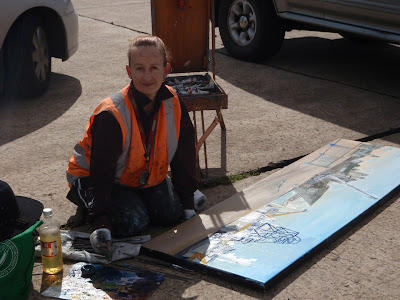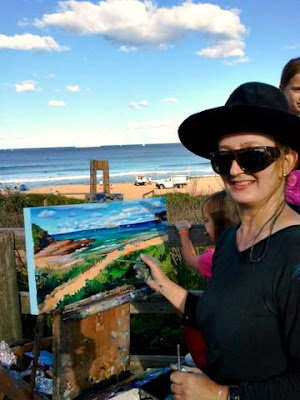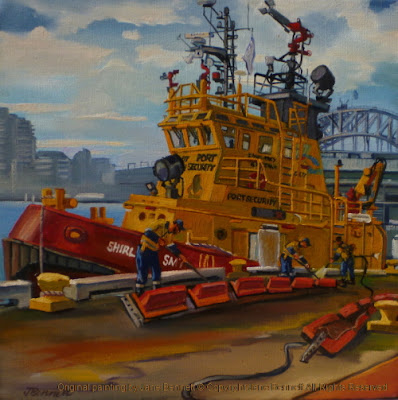I have been asked to create some paintings inspired by the Rookwood necropolis
for the exhibition "Spirited - Impressions of historic Rookwood" at the Peacock Gallery in the Auburn Botanic Gardens which will coincide with the "Hidden" exhibition at Rookwood.
 |
| My clay model of the Dixson Monument, Rookwood |
 |
| My clay model of the Dixson Monument, Rookwood |
At 700 acres, Rookwood is one
of the largest burial grounds in the world and one of Australia's
oldest cemeteries. Exploring its grounds can be overwhelming - a recipe
for Stendhal's syndrome.
 |
| My clay model of the Dixson Monument, Rookwood |
 |
| My clay model of the Dixson Monument, Rookwood |
And if I do get Stendhal's syndrome I could even get as “'crook as Rookwood”. Old fashioned Australian slang has almost completely "gone to Gowings"
- as now Gowings has well and truly gone to Gowings for good. The
saying "Crook as Rookwood" in fact has very nearly died out.
 |
| My clay model of the Dixson Monument, Rookwood |
And
at first I was completely and utterly overwhelmed. Ideally, the best
course would have been to join one of the tours, but I have had little
time left over after a year with a brutal exhibition schedule - 5 solo
exhibitions in 6 months and many group exhibitions and commissions. The
tours have not coincided with the small amount of spare time I had left.
 |
| My clay model of the Dixson Monument, Rookwood |
So many wandering paths, so many sections, row upon row of headstones, so much ground to cover.
From crisp and glossy to sagging and neglected; which to notice and
which to ignore. All seemed to deserve attention but which to choose?
Everything beckoned, but nothing compelled.
Lost in the city of the
dead with no destination.
I wandered at random and let chance be my guide.
 |
| My clay model of the Dixson Monument, Rookwood |
And by chance I
discovered one of the most beautiful sculptures in Australia, the
Dixson Monument. I also discovered a true reason for creating a painting
as not only did this sculpture commemorate a great unsung hero of
philanthropy, but one to whom I owe a great debt of gratitude.
 |
| My clay model of the Dixson Monument, Rookwood |
Apart from its beauty, I have personal reasons for being attracted to paint the Dixson Monument. Sir William Dixson, collector, philanthropist and connoisseur, is one of my heroes. Although he died many years before I was born, he was my benefactor.
 |
| My clay model of the Dixson Monument, Rookwood |
Sir William Dixson had already funded numerous
charities and educational institutions throughout NSW. When he learned
that the income from David Scott Mitchell's bequest to the Public
Library of New South Wales was not able to be spent on pictures, he
left a generous bequest to buy historical pictures.
 |
| My clay model of the Dixson Monument, Rookwood |
I am a present day recipient of his generosity, as the
Mitchell Library now has a collection of 21 of my paintings. Without
Sir William Dixson's bequest , the Library may never have decided to
collect paintings at all.
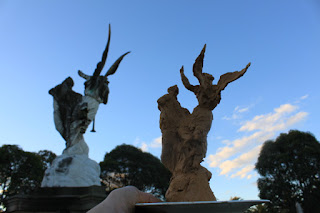 |
| My clay model of the Dixson Monument, Rookwood |
All the other sculptures look a bit lumpen and flatfooted in comparison to the Dixson sculpture. If any sculpture deserves the title "Spirited" it must be this.
 |
| My clay model of the Dixson Monument, Rookwood |
It is exuberant, joyous and full of energy. The keynote is exultation
rather than mourning. It conveys passion, emotion and the humanity of
the moment.
 |
| My clay model of the Dixson Monument, Rookwood |
I know that the sculpture is not just dedicated
to Sir William, but the entire Dixson family, however it is a
flamboyant monument for such a shy and reserved gentleman.
 |
| My clay model of the Dixson Monument, Rookwood |
 |
| My clay model of the Dixson Monument in Rookwood Necropolis |
It is also an intricate and complex work. The
figures are interlocked in a swirling vortex of drapery that seems to
defy gravity.
 |
| My clay model of the Dixson Monument, Rookwood |
I circled it slowly for hours, looking at it from every angle and started a few tentative sketches. Finally I decided that I would need to create a rough model in clay before even attempting to paint it.
My clay model is not intended to be a sculpture, but part of the process of understanding the complexity of the original so that I can do it justice in my painting.
 |
| My clay model of the Dixson Monument, Rookwood | | |
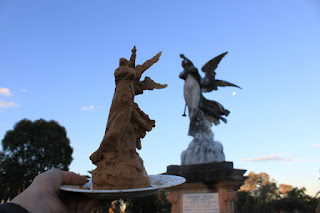 |
| My clay model of the Dixson Monument, Rookwood |
This sculpture is so completely 3 dimensional. Every angle reveals another nuance.
 |
| My clay model of the Dixson Monument, Rookwood |
 |
| My clay model of the Dixson Monument, Rookwood |
The closest that I can think of to emotion and virtuosity of the Dixson monument is the work of the Baroque sculptor Bernini and I have included below a copy of his "Apollo and Daphne" for comparison. The original marble sculpture is in the Borghese Gallery, Rome.
|
|
| A statue of Apollo and Daphne after Bernini at Council Staircase in the Hermitage. (Photo credit: Wikipedia) |








































